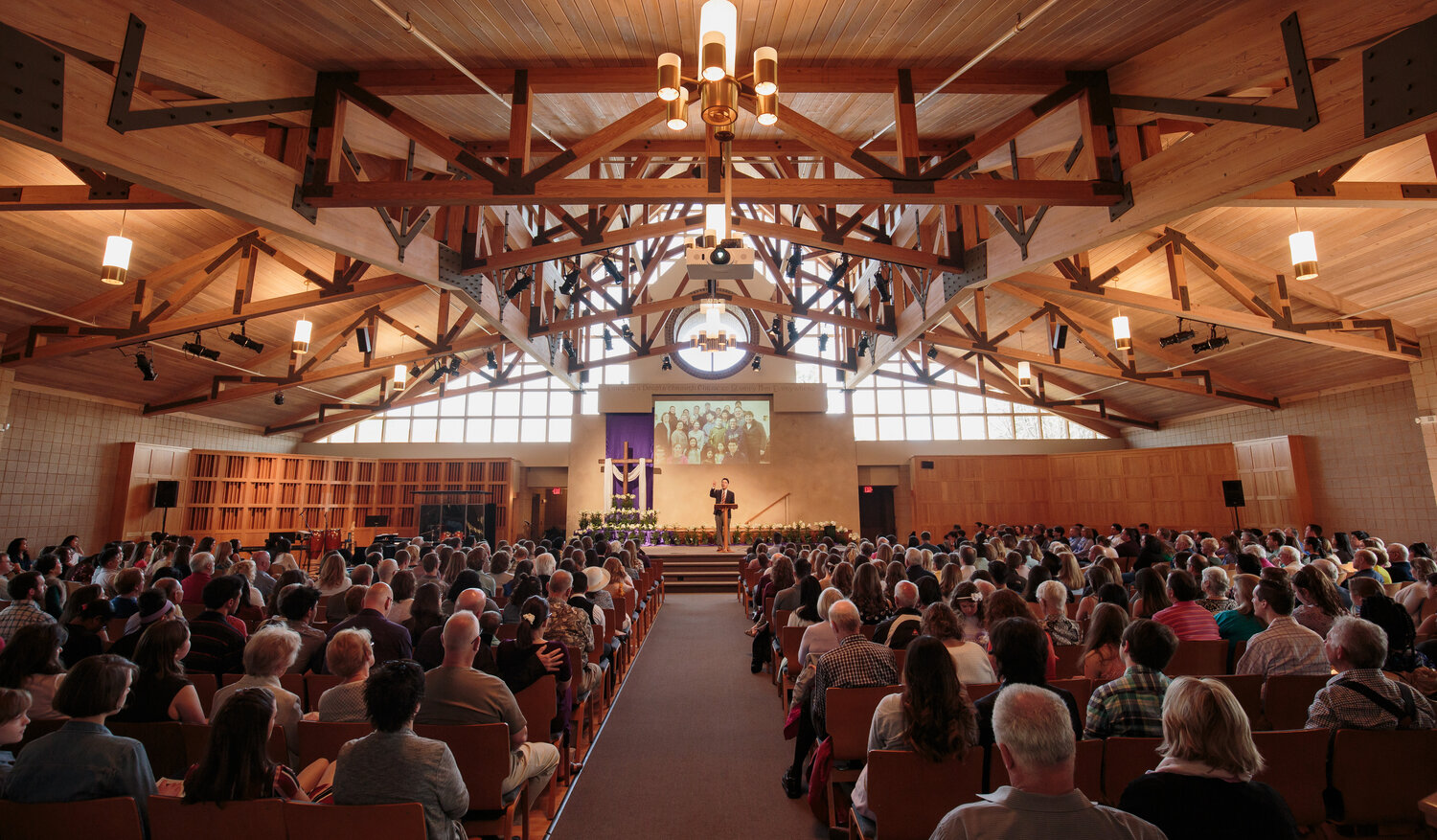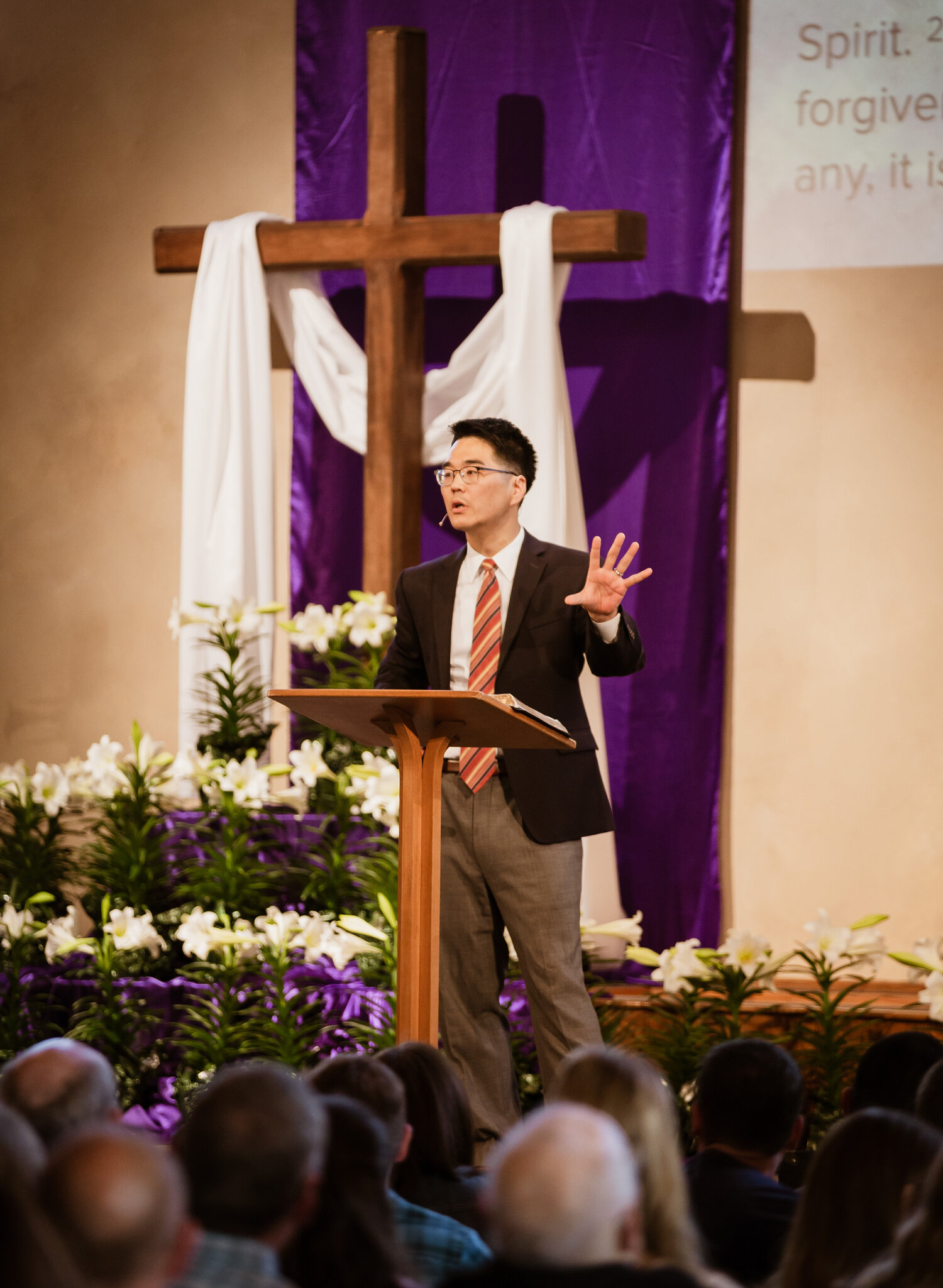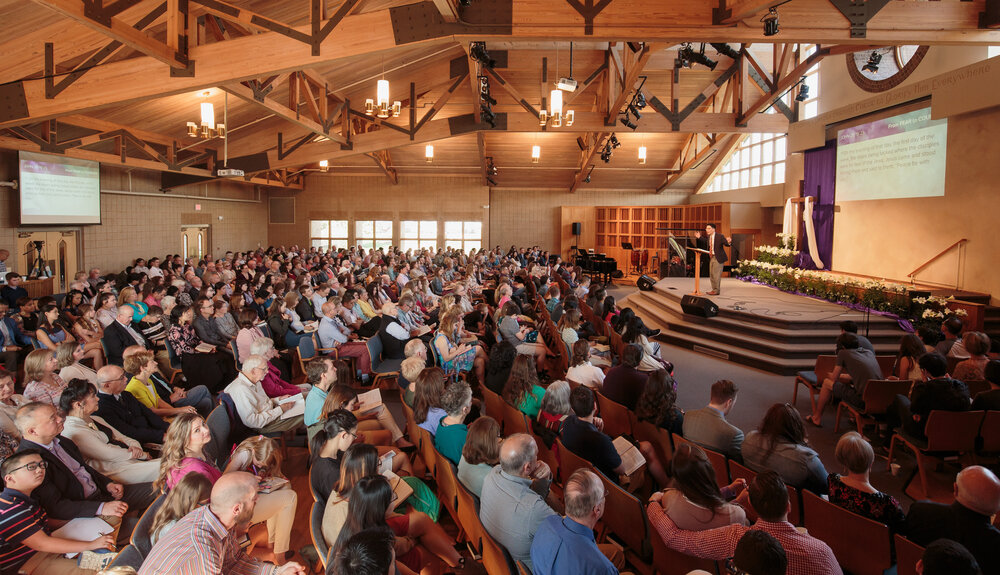Mitch Kim was enjoying being the lead pastor Living Water Alliance Church, a small but growing Asian American congregation in Wheaton, Ill. Then he got a phone call from a leader within his church’s denomination. Would he be open to merging with Blanchard Alliance Church, a large but slowly declining majority white church that hadn’t had a permanent senior pastor for years?
That began Kim’s journey into merging two congregations into one church. That church combined Blanchard and Living Water to create Wellspring Alliance Church, which was founded in 2016, with Kim as the lead pastor.
I spoke to Pastor Mitch Kim over Facetime, and he shared why the two congregations merged and the new culture he and his church is striving to create. He also discussed the impact and importance of being an Asian American who is pastoring a multicultural church.
Hannah Chao: What was your relationship with Blanchard Alliance Church like while you were still pastoring Living Water Alliance Church?
Mitch Kim: We’re both part of the Christian and Missionary Alliance denomination. Blanchard has two campuses, and we were actually using one of their campuses for prayer meetings, leadership training stuff during the week. They were kind of the big white church down the road. I had even done some pulpit teaching when they lost one of their campus pastors.
So how did the talk of this merger come about?
Blanchard’s senior pastor had retired a few years back, and they had a series of interim pastors. I got a phone call in the summer of 2014, and the [denomination’s] district superintendent, who helps oversee the churches in this area, asked, “Would Living Water be open to merging?”
My first thought was no because Blanchard was a large church that had been in decline for about maybe 10 years. And I felt we’re really having fun, second-generation ministry, and Asian American, Pan-Asian, and people were coming to Christ and growing, and DNA of the church was really suiting my heart. And so my initial thought was, “Why would I hang the albatross of Blanchard around the neck of a young, growing church?” I was very hesitant.
What changed your mind?
As I brought it before the Lord, he reminded me of something because I’ve been praying for our area. When you don’t have a [church] building, you notice what’s going on in your area much more. You think, “Oh, maybe we can use that,” and I noticed a lot of churches turning into mosques and Hindu temples in our area.
Also, the demographics of this area have gone from about 90% white to about 60-70% white within 15 years. Basically, the slice of the pie was shrinking for majority-Anglo congregations as more minorities, especially Southeast Asians, came in.
As an East Asian American church, I didn’t know what we could do. We’re going to attract a lot of Chinese, a lot of Korean-Americans, some Vietnamese, some Japanese-Americans — the kind of typical demographics of a Pan-Asian church, which was great; we’ll reach people like us. Blanchard would also reach people like them, but there’s still a lot of people in our area that need to know the name of Jesus. And so that issue — how will we reach the diversity of our area? — that’s what opened my heart. Would we be better together to reach a diversity of area?

So then how did Living Water and Blanchard come to the same table to start talking about merging? How did that work?
[Blanchard’s] elders, their leadership, wanted to meet me, so I met them. They eventually came back and said, “This is the way we want to move forward.” Then we formed a task force of five people from Blanchard and five people from Living Water to explore what would it look like if we were to merge.
They spent probably six months studying it — everything from finances to staffing, to home groups to philosophy of ministry, to doctrine — and really going through with a fine-toothed comb. A lot of good, hard work happened because I didn’t want to say, “Let’s try it for six months, and then we’ll see if it works out.” I didn’t want to do that. That would bring too much damage.
I said, “If we’re going to get married, let’s get married. And through thick or thin, we’re together. And if we want to walk [away], let’s walk before we make a covenant to come together.” So that’s how the process went.
Once that committee completed its work, and they recommended the merge, how did the two congregations react?
Well, they were involved in the whole process. They knew about the exploratory task force, and we would have town hall meetings periodically to listen to questions from both sides. On the Blanchard side, some asked, “Do we have to take this extreme of a step?” But it was very actually supportive on the Blanchard side.
There was a little bit of more fear on the Living Water side because we have our Asian American safe space. “We spend all day every day as sort of foreigners in majority culture space. Why would we give up our safe space for this?” That was kind of the question in people’s minds. And the reality was there’s a lot of good Asian American churches in our area. But I felt it’s a mission. And we said this a lot: “Mission over merger.” The goal is not a merger. The goal is God wanting to extend his mission in some critical ways, and we want to move forward in that.
What were some of the benefits and changes that came out of merging?
They didn’t have a senior pastor at the time, and so, they needed leadership. So, in a crass way, you could look at it and say, “Oh, they need a pastor. We needed a building.” But it was a lot more than that. We made it very clear that this is more than just us getting a building, you getting a pastor; it really is about creating a hybrid third reality.
A lot of multiethnic churches are like a flower bouquet, where the best day of a flower bouquet is its first day. You cut off the flowers from their roots, you put them together, and it looks beautiful. But it wilts over time. What often happens with a multiethnic church is you kind of remove people from their context, and there’s a dominant culture, whether it’s white or Asian or whatever else.
And yet what I felt we were called to is more of a graft than a flower bouquet. Because in a graft, you take two sprigs and you bring them together, and it creates a third hybrid reality, that is neither A nor B. It’s a C. It’s like when two parents get married and have a kid. The kid is neither mom nor dad; it’s a new life.
As a graft, we didn’t want to just assimilate to white culture. We also didn’t want the Blanchard to just assimilate and do it our way now. But we felt there are unique strengths from both sides that we wanted to combine together. So, from the Asian American heritage, there’s a strong, prayerful spirituality and a sacrificial community. Those are the two values we feel that were coming out of our Asian American heritage.
With the Blanchard side, there was a very seasoned maturity. There were elders, and retired missionaries, and people who’d been following Jesus all their lives, and just incredible depth. There was also a commitment to world mission, seasoned commitment to missions, love for the word. But really the word was maturity, I sensed from them. And so I felt the maturity of Blanchard could help stabilize the passionate energy that we had at Living Water.
Living Water was a sailboat that could go fast, and was going fast, but it could easily capsize. Blanchard was kind of this big cruise ship, but it couldn’t seem to turn. But the weight and ballast, the maturity of Blanchard, could temper some of the vision, and passion, and energy of Living Water, to create something new.
So then how does that play out in some of the programming at your church now? The maturity versus the prayerfulness and the spirituality?
Mitch Kim: So the first thing we started with prayer meetings. So Wednesday night, Saturday morning prayer meetings…
How early on Saturday mornings? Not 5:00am, right?
Oh, no. 7:00am. Our prayer meetings are our core place for prayer. But then we also model it, and I’ll preach about it a lot, just because it’s sort of in my DNA. And I feel that’s part of the heritage, from the Korean-American church, is a passionate commitment to prayer.
Do people pray out loud at your church?
Mitch Kim: Yeah, even during Sunday service, I’ll do one voice prayer. So after I preach, I’d say, “Hey, let’s pray for X,” and we’ll pray out loud for a few minutes. Sometimes it makes some people go “Whoa,” but I explain that this is not just my cultural tradition. You see it in Scripture in Acts and in Gethsemane, where Jesus prayed a stone’s throw away, but his disciples heard him. Prayer was not just an individual’s silent affair.
We’re teaching people that it’s not my culture versus your culture, but it’s the Bible. But different cultures will end up highlighting and growing different strains from the Bible better, and so we need to learn from that.
And then with the Blanchard maturity, some of the home groups have been places that have grown from that. We’ve had marriage groups, where older couples and younger couples coming together. And so, just lots of different ways to have people relate together. And even our governing board, our elders, from both congregations work together. At the end of the day, it’s all relationships, right? We provide opportunities for relationships so that programming can reflect the unique heritages of both.
I read in one of your blog posts that you kind of feel like your church is kind of an adolescent stage, where before it was exciting and fun, but now you’ve got some growing pains. Where do you think your church is right now, in terms of becoming one body?
Mitch Kim: So, change discombobulates. And from both sides, there’s been significant change and significant growth. So we’ve almost doubled in size, which is a rapid pace of growth. At first, there was a lot of grief. “Wow, we lost Blanchard.” “Oh, wow. We lost Living Water.” We had to navigate that grief by celebrating the past. But now that it’s four years in, it’s much more about Wellspring.
This year, we’re preaching through Exodus, and the theme is “Coming Home” because we want to create a sense of home here. Exodus is a journey out of slavery in Egypt and into the presence of God. As I look at Exodus 12:38, it says that
coming out at the Exodus was a “mixed multitude.” So it’s not just Israelites. They’re Egyptians, they’re Philistines, and people from different places.
So, the first multiethnic church wasn’t in the New Testament. The first multiethnic people of God is actually the Exodus. And they had to create culture: the Passover, the Feast of Unleavened Bread, the Ten Commandments, and the Book of the Covenant.
We think of a lot of these things as timeless things to practice, but they actually were critical to create a healthy, unified culture for God’s people coming from many different backgrounds. And so I feel what we’re really pressing into right now is building culture. And it’s not just what are we going to do, but it’s what kind of people are we going to be, what kind of culture are going to cultivate, and we really want to focus on that.

Let’s go back a little bit. So since your merge, do you feel this idea that you had to reach out to more than just the East Asian church and the white church has panned out?
Yeah, I feel we’re just figuring it out. We’ve been growing in diversity — African American, Hispanic — but not as much in South Asian communities because I think to reach the South Asian community, people aren’t just going to be attracted to it, you have to go and reach them.
It may not be that we reach the South Asian community; maybe we plant churches. And that’s actually more of my heart because if we can be a resource of people planting churches, let’s do it. And so, praying about what would that look like in the future. I do believe that as we navigate the cultural challenges that we have, then we’ll be more equipped to navigate other cultural bridges of Christ.
How do you think being Asian American has helped you as a pastor and to lead into this role that you have now?
Yeah. It’s a blessing and a curse. It’s a blessing in that I learn quickly, and I adjust the cultures quickly. You kind of see what’s going on, you figure it out, and you know what to do. The curse of it and the difficulty has been: If I know my way is a way, and you think that your way is the way, then it’s easier to just let you do your thing, rather than actually help you see that your way, which you think is the way, is actually a way that we can negotiate what will be a better way. That’s tiring. And so that’s the challenge of leading as an Asian American leader — not assimilating.
In Lean In, Sheryl Sandberg talks about how women in the corporate setting need to lean in and not just be deferential at the leadership table. I read an article that said that Asian Americans need to take the same posture. Often as an Asian American, I feel I’m deferential. I’ll only speak if you ask me to speak. And I’ve learned that, no, I have to lead.
The church in North America, the Anglo church, needs our voice in leadership. The prayerful spirituality, the understanding of church as a community, and not just a place to get your spiritual Starbucks and move on. In the Korean church, Asian American church, you spend a lot of time together, and it’s almost too much; it’s almost ingrown at times. But there is a fixed sense of community, where culture, and life, and values are being shaped; and it’s also your safe space. Those are some of the values I feel that we bring as Asian Americans.
So how has leaning in helped you to become a better pastor for your church?
I feel it’s been important for me to lean in and actually lead so that I can discern and help the church be what God’s called it to be. And it’s been a journey. I had led only in Asian American settings before, and I loved it. I never wanted to leave. I had no dreams of a multiethnic church. At the same time, I was teaching at the Wheaton Graduate School, and so I was having a blast with what I was doing.
But for the first time in my ministry, people who didn’t look like me were asking me to lead. And I realized, “Oh, I can do it. I’ve done it only with people who look like me, but I can do it.” And as I’ve done it, I think breathed a new air in the church. And so people have been growing. By bringing two things together, we’re creating a third reality, and it’s kind of in those places of discomfort you grow. And I feel that’s been the case for both sides. And I think, as we’re growing, our capacity to reach out is also growing.
How do you think Wellspring’s story can help the greater church?
Our story is a story; it is not the story. As an Asian American, I’m really grateful for SOLA’s ministry. I’m grateful for the way that it’s a platform, and it’s encouraging people to find Asian Americans to express the unique way that God has formed us. And I think my prayer, my heart, is we would continue to find our voice. That the church of Jesus Christ really needs all kinds of sectors of the church to share.
In the picture in Revelation 7 of every nation, tribe and tongue gathered before the Lamb and in the one in Revelation 20, where the kings of the earth bring their goods, bring their glory, into Jerusalem, there’s a sense that different cultures bring unique facets of the glory of Jesus into Jerusalem. Each culture, each story has a unique facet of the glory of Jesus Christ that we want to be able to bring in, and so I just hope and pray that we could do that well. Because as you do it, it’s not our glory, it’s a glory of Jesus that we’re shining. And we want that to shine very clearly.

